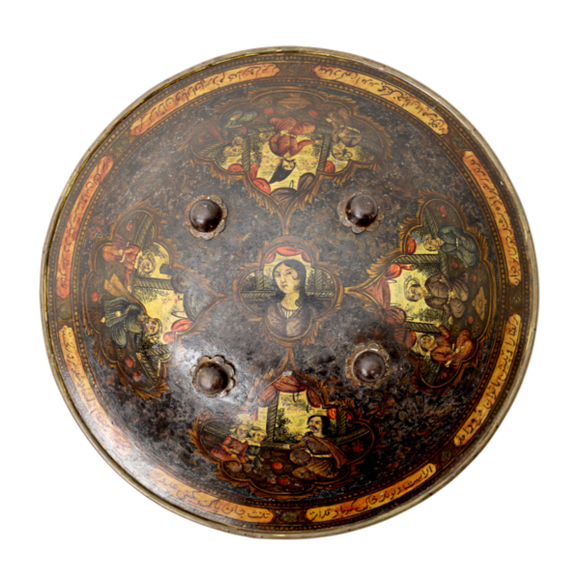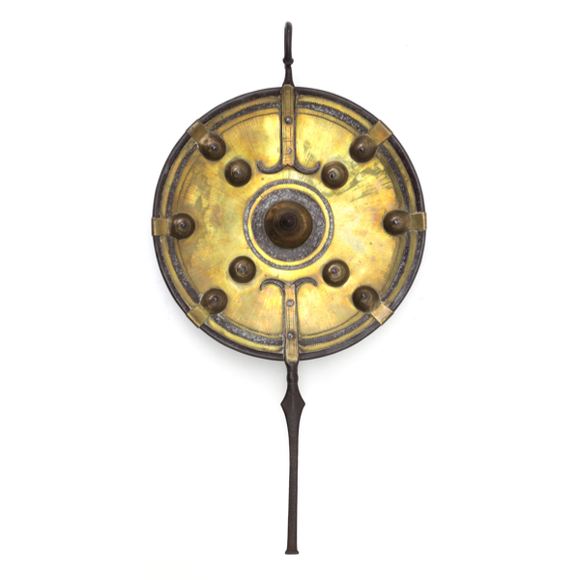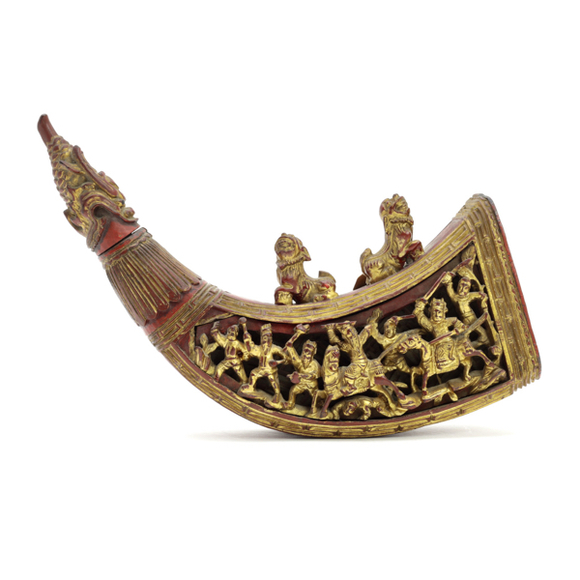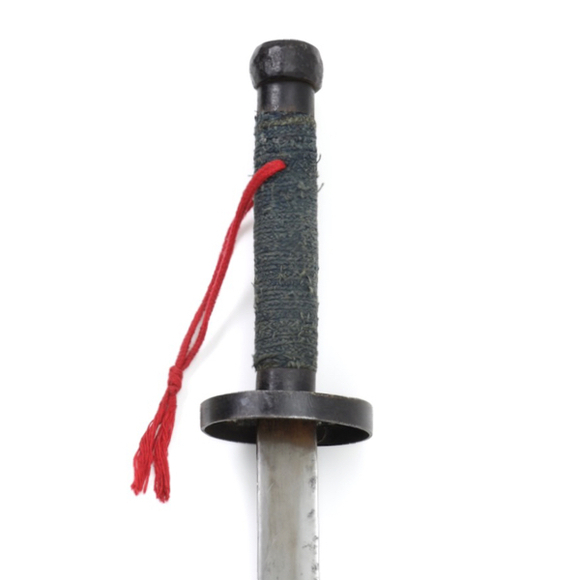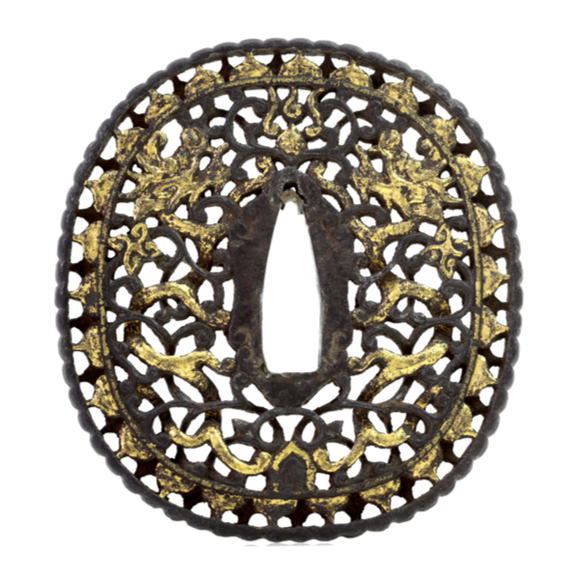Language: Mandarin Chinese
Source: Classical literature
Introduction
Téngpái (藤牌) literally means "rattan shield". It was a circular shield, made of a large spiral or rattan that was bound with strips of rattan skin. Such shields are described in use in China from at least the Song dynasty (960–1279). It probably originated in southern China, and has always been strongly associated with Fujian. Rattan shields have long been in more widespread use in southern China where the subtropical climate is less suited for full armor.
The téngpái was used in conjunction with a saber. In Qing times texts mention them being used alongside so-called piāndāo (㓲刀) or "slicing sabers" as well as páidāo (牌刀) or "shield sabers". Late 19th century photography also shows long, single húdiédāo (蝴蝶刀) "butterfly swords" used along with shields. There is a good possibility that these were also simply called páidāo at the time.
The Qing imperial army made use of rattan shield skirmishers of the Téngpái Yíng (藤牌營) or "Rattan Shield Batallion" who had shields with tiger faces painted on them, and were dressed in a full tiger uniform.

 A Chinese rattan shield of the 19th century. Previously in my collection.
A Chinese rattan shield of the 19th century. Previously in my collection.
In historical sources
The Dutch V.O.C. encountered rattan shield troops lead by Coxinga, who in 1662 managed to expel the Dutch from Formosa (Taiwan) to establish the island as a base for his Ming loyalist movement.
"... his soldiers used three types of weapons, some were armed with bow and a quiver hanging from behind their backs, others had a shield on their left arm and a good saber in their fist. The third kind had a large battle sword on a staff half the length of a man, held with both hands.
The shieldmen were used in place of cavalry, who were guided by their commanders, one every ten men, with their shields covered, with lowered heads, tried to penetrate the enemy lines, and bring disorder, which they did with such fury and carelessness, as if each of them had left a spare body in a crate at home, penetrating enemy lines enduringly, notwithstanding how many of them were overrun, on which none took any note, as to proceed as wild dogs, without ever looking back to see whether they were followed [by their companions] or not.
Those with battle swords on staffs, called “soap knives” by the Dutch, are in the place of our pikemen, to prevent breaching [of the lines], and to preserve order among the troops, but when the enemy was brought in disorder, they would massacre the fleeing men."1
-Frederik Coyett, 1675
The 1766 Huangchao Liqi Tushi (皇朝禮器圖式) still lists large knives on poles as being used by the imperial Rattan Shield Troops of the Téngpáiyíng (藤牌營).2 This suggests that the formations mentioned by Coyett in the 17th century remained pretty much intact in mid-18th-century Chinese warfare.

"Rattan shield army rattan shield" in the 1759 Huangchao Liqi Tushi.
Notes
1. Frederik Coyett; 't Verwaerloosde Formosa, by Jan Claesz. ten Hoorn en Michiel Pieters, 1675. (My own translation from old Dutch.)
2. Huangchao Liqi Tushi (皇朝禮器圖式), or "Illustrated Regulations on the Ceremonial Paraphernalia of the Dynasty", Palace Edition of 1766 (British Library, 15300.e.1). By Pu Jiang et al., eds. This version is based on a manuscript of 1759.
Into the 19th century
An account from the steamer Nemesis, which was active in the first Anglo-Chinese war from 1840-1843.
"The war-junks are of different sizes, and have guns varying in number from four to fourteen, and even more, mounted upon them, of various calibre, some of foreign make, but principally Chinese. The smaller junks are also adapted for oars or sweeps, of which they sometimes can work as many as twenty on either side. The crew are further provided with a great number of spears, swords, matchlocks, and frequently large jingals, not unlike our musquetoons, fitted with a rest upon the bulwarks of the vessel, so as to give the power of taking a steady aim. There are generally a large number of round shields on board, made in a saucer-like fashion, and about two and a half to three feet in diameter. They are composed of ratans, or canes, strongly twisted or woven in together, and are so elastic, that it would be very difficult to cut through them with a sword; and even a musket-ball fired from a long distance, and hitting them at all in a slanting direction, would be turned off. They are usually hung all round the bulwarks, resting upon the top and outside of them, giving a very striking appearance."
-William Dallas Bernard & Sir William Hutcheon Hall
Narrative of the Voyages and Services of the Nemesis from 1840 to 1843
Here a Chinese official recalls a review of the troops:
The cane shield corps were really not a regular force, for they never had barracks to live in or headquarters to go to. Most of them were notorious rowdies of the town, who spent their time in fighting and quarreling.
With the exception of the leader, who received regular pay from the magistrate, the others were paid only during the months of spring and autumn, when the Prefect reviewed the local garrison.
But nevertheless they knew their business better than the soldiers, as they practiced more and had real experts to train them.
They came on in pairs, each man carrying a shield and matched with another man with either sword or spear. They maneuvered round and round the enclosure, cutting' and parrying. Gradually the men with the shields worked round the men without shields, and encircled them. At this juncture about forty or fifty mounted soldiers came galloping in, and tried to attack the shielded men in order to save the surrounded men. The shielded men at once fell flat on the ground and began to roll and roll towards the horsemen. This was supposed to be a deadly attack upon the horses, and the latter retired. At the same time the men inside had got out, and so ended the attack.3
-Reminiscences of a Chinese official, 1922

Rattan shield troops in the London Illustrated News of July 1900.
Notes
1. William Dallas Bernard & Sir William Hutcheon Hall: Narrative of the Voyages and Services of the Nemesis from 1840 to 1843: And of the Combined Naval and Military Operations in China : Comprising a Complete Account of the Colony of Hong-Kong, and Remarks on the Character & Habits of the Chinese, Volume 1. H. Colburn, 1845. (See at gutenberg.org.)
3. Charles William Wason; Reminiscences of a Chinese official, Reprinted from the Peking Gazette and the China Illustrated Review, Tientsin Press, Limited, Tientsin 1922. Page 66.
Tiger iconography
Rattan shields of the Qing dynasty were frequently painted with a stylized tiger face, often with the character wáng (王) or "king" on their forehead. They fascinated foreign observers. The stylized tiger painted on the face of most of these shields were often explained as "grotesque demon faces" that undoubtedly served to scare the opponent. Quite the opposite was true. The word for tiger is pronounced hǔ (虎) in Mandarin, which sounds very close to the word for protection, hù (護). Tigers have long been regarded as protective deities and images of tigers were pasted on doors, and even appear on children's hats to ward off evil. The tigers on these shields were there to reassure the often highly superstitious Qing soldiers of their protective qualities.
Effectiveness
Such shields may appear of limited effectiveness, but I have made and tested a shield and the result was surprising. You can, in fact, cut into its rim 10-15 cm, but your sword or saber will be completely stuck. Thrusting into the shield gives similar results. So in a fight, the last thing one would want to do is hit the shield and have it capture your weapon; the shield-bearer will be quick to respond with his saber.
They were easy to produce, light, and relatively inexpensive. There were of course also limitations. Bullets went right through them and in the late 19th century the shield troops were somewhat of a relic on the field.

